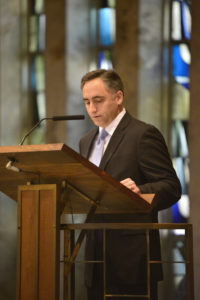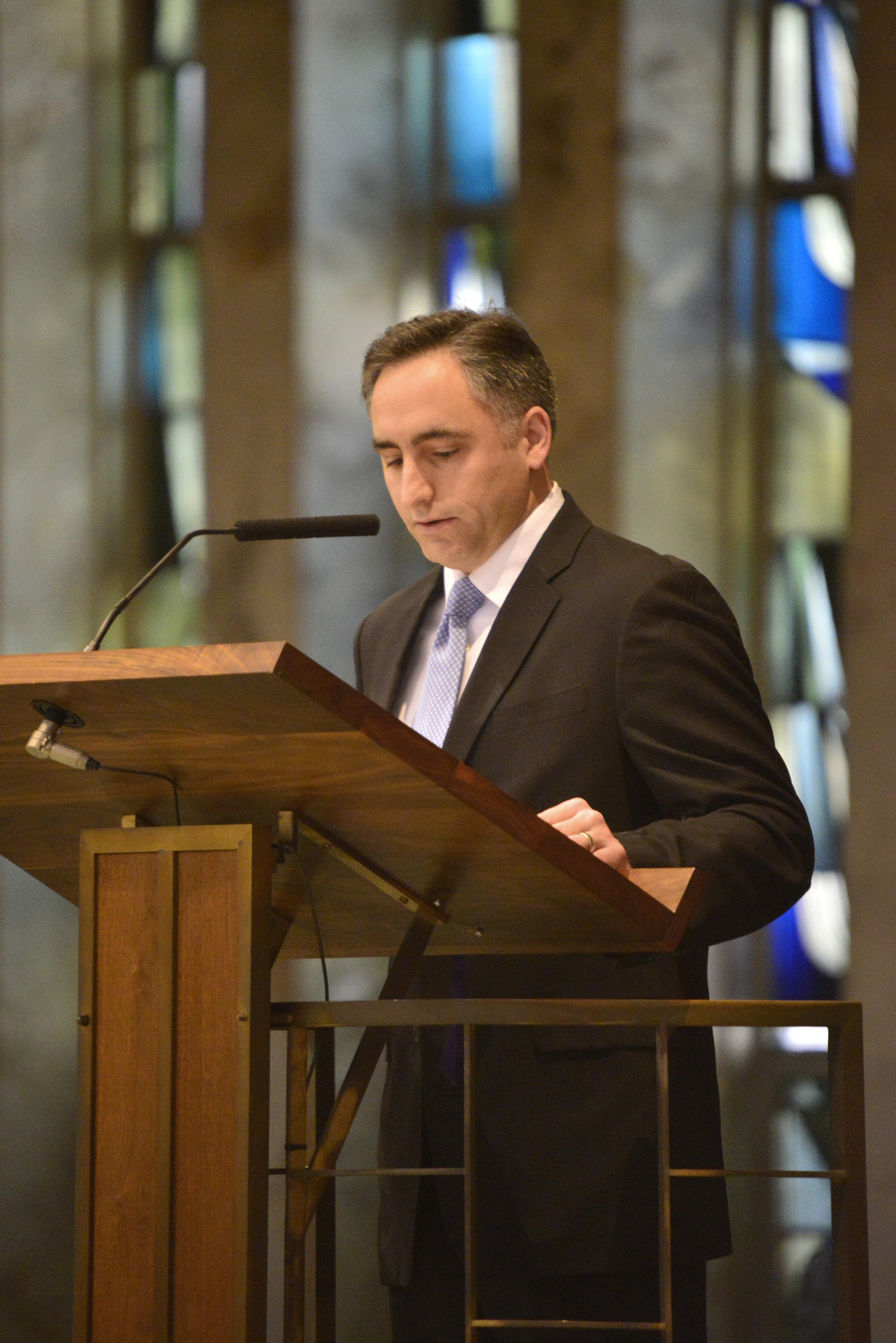 One of the parts of the Ordinary Form of the Mass that was restored from antiquity is the Prayer of the Faithful. In my mind, however, there is an often disappointing quality to the intentions as they are used today. They are either overly particular and ideological or, at the other end of the spectrum, perfunctory and flat. Further, they often include prayers for the Pope, bishops, clergy, and also for the dead. But these sorts of prayers will be included in the Eucharistic prayer. Why “predundantly” include them here?
One of the parts of the Ordinary Form of the Mass that was restored from antiquity is the Prayer of the Faithful. In my mind, however, there is an often disappointing quality to the intentions as they are used today. They are either overly particular and ideological or, at the other end of the spectrum, perfunctory and flat. Further, they often include prayers for the Pope, bishops, clergy, and also for the dead. But these sorts of prayers will be included in the Eucharistic prayer. Why “predundantly” include them here?
Some years ago, Peter Kwasniewski, in an article at New Liturgical Movement.org (here), summarized the problem very well.
It is surely no exaggeration to say that throughout the world the quality of these intercessions has tended to be deplorable, ranging from trite and saccharine sentiments to political propaganda, from progressivist daydreams to downright heretical propositions to which no one could assent without offending God. Even when the content is doctrinally unobjectionable, all too often the literary style is dull, flaccid, rambling, or vague. … [There is] problematic content, poor writing, and [a] monotonous manner of delivery.
Additional problems occur when there are people of many different nationalities present and it is felt necessary to have the petitions read in multiple languages. The impression is given that the intentions are directed more to the congregation than to God, who knows all languages and thoughts. I have been at Mass in the Basilica here in Washington, D.C. when as many as nine different languages were used in the Prayer of the Faithful, despite the fact that the vast majority of those present spoke English and/or Spanish. I seriously doubt that there were more than five people in attendance who could speak only German, Mandarin, or one of the other languages used. It quickly gets very tedious as a line of people traipse back and forth to the microphone.
It is all so different in the Eastern Liturgies, in which the Great Litany is so artfully woven into the liturgical experience and beautifully sung as well. I have memorized the Great Litany from the Liturgy of St. John Chrysostom (see video below).
In his article (here), Mr. Kwasniewski offers a variety of intercessions, and download links are provided. I have done so for my own use and you might wish to do the same.
I would also like to add that St. Peter Canisius composed intercessions for use in his time. Saints are certainly reputable sources of such things! Here is an article by Mark Woodruff that details those prayers.
The point is that much can be done to improve the quality of the Prayer of the Faithful, which has remained an amateur outing at best and an ideological hornet’s nest at worst.
Perhaps some benefit can be obtained from reviewing the norms and the history of this portion of the Mass.
The General Instruction in the Roman Missal (GIRM) has this to say about the Prayer of the Faithful:
In the Prayer of the Faithful, the people respond in a certain way to the word of God which they have welcomed in faith and, exercising the office of their baptismal priesthood, offer prayers to God for the salvation of all. It is fitting that such a prayer be included, as a rule, in Masses celebrated with a congregation, so that petitions will be offered for the holy Church, for civil authorities, for those weighed down by various needs, for all men and women, and for the salvation of the whole world. As a rule, the series of intentions is to be
-
-
- For the needs of the Church;
2. For public authorities and the salvation of the whole world;
3. For those burdened by any kind of difficulty;
4. For the local community.
- For the needs of the Church;
-
Nevertheless, in a particular celebration, such as Confirmation, Marriage, or a Funeral, the series of intentions may reflect more closely the particular occasion.
It is for the priest celebrant to direct this prayer from the chair. He himself begins it with a brief introduction, by which he invites the faithful to pray, and likewise he concludes it with a prayer. The intentions announced should be sober, be composed freely but prudently, and be succinct, and they should express the prayer of the entire community (GIRM 69-71).
History – These intentions were very common in the early Church, occurring at about the same point in the Mass as today. They followed the Homily (note that in earlier days the Creed was typically not said). All of the Fathers of the Church make mention of them. In the beginning, this prayer was recited antiphonally by the priest and the assembly. Over time, the deacon assumed a more prominent role; he announced all the intentions and then the faithful responded with Kyrie eleison or some other acclamation. You can read the Kyrie Litany of Pope Gelasius here.
These intercessions endured until about the 9th century, well past the close of the patristic period. Their disappearance seems to coincide with their evolution into a Kyrie litany and their transfer to the beginning of the Mass. They eventually came to be regarded as an unnecessary appendage and were phased out. In the West they were used only on Good Friday, though they endured longer in certain particular areas. In the East they were never dropped. Today they have been restored to their original place in the Mass.
Further pastoral reflections – One reason that they are called “general intercessions” is that they extend beyond the needs and concerns of the local assembly. Please note that they are not called the particular intercessions. What sometimes happens in more extemporaneous settings is that certain very specific needs are expressed; the list can become quite long. It is not appropriate here to pray, “for my Aunt Sue’s friend, who is recovering from hip surgery and having a hard time due to her diabetes.” It is more appropriate to pray, “for all who are sick or struggling in at this time.” The point is to keep it general; this is not the time for a full medical update on everyone’s relatives or friends.
Calling it the “Prayer of the Faithful” has some historical merit because catechumens and others were dismissed before the proclaiming of the intentions. Another reason it is also common to call them “general intercessions” is that the whole Mass is really the prayer of the faithful. Through his opening prayer, the priest may link the intercessions to the reading, and through his closing prayer he may summarize them. This can help to place them in a clear context. Singing the intercessions is a beautiful option and is surely of ancient practice (cf Music in Catholic Worship # 74).
In the end, I think these intentions deserve better than we have given them. I realize that enthusiasts of the Traditional Latin Mass (of which I am one) may say, “Just get rid of them entirely,” but that is not realistic. They are here to stay, at least in our lifetime. Maybe we can try to do better by making use of multiple sources: ancient, Eastern, and modern yet elegant. I am interested in your thoughts and also any references to good additional sources.
Here is the Great Litany from the Liturgy of St. John Chrysostom:


I listened to the Great Litany and it is beautiful. But if only “general intercessions” are considered appropriate for the prayer of the faithful, then the great litany, though beautiful, suffers from the same fate as anything that is so general as to be whatever you want it to be. Frankly, I can barely listen to the prayer of the faithful these days as we pray for everything and anything, and, in the end,nothing of much significance.
Yes! Thank you, Monsignor. I cringe when we’re traveling or have a guest priest and they let the congregation shout stuff out. Your Aunt Sue example is barely an exaggeration.
Thank you, Monsignor, for another excellent article.
Weighing in as a layman from the Ordinariate circle within Holy Mother Church, we have five forms of ‘The Prayers of the People’ in Divine Worship: the Missal (pp. 1048 to 1057). Each form allows those gathered to have their individual intentions enveloped within or captured by the Prayer. Each form, drawn from the Patrimony, has a distinct character. Among the forms are versions of the intercessory Prayer that are in the form of a litany that may be chanted by the congregation according to very singable formulas employing elevated English. Perhaps those celebrating the Novus Ordo Missae could borrow from the content found in the Ordinariate Missal.
https://saintgregoryordinariate.org/wp-content/uploads/2013/05/DivineWorshipPewMissalWEB.pdf
pp. 25 to 34 in the linked PDF
As soon as I read the title of this article I knew what it was going to be about. The intersessions are very often monotone, dull, and very specific. As you mentioned, the Pope, Bishop, and all the clergy are remembered in the Mass already. This is an excellent article and I pray many Pastors will read it (my personal intention today).